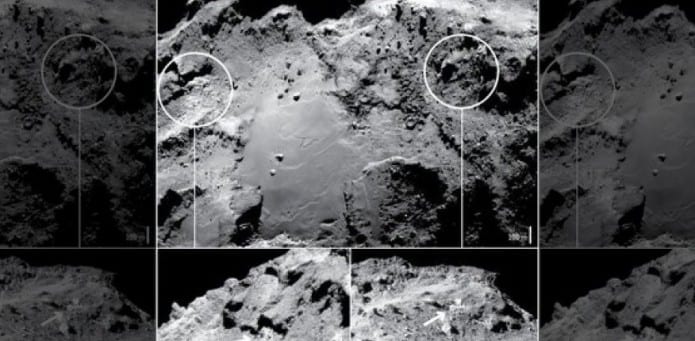Rosetta orbiter confirms two types of water ice spotted on Comet 67P’s surface
The European Space Agency (ESA) for the first time has confirmed the existence of large patches of water ice on the comet 67P’s surface, thanks to ESA’s Rosetta orbiter. The patches are assumed to have formed a dry, crunchy coating over an ice-layered core of the iconic comet called 67P/Churyumov-Gerasimenko.
“First, not finding ice was a surprise; now, finding it is a surprise,” one of the team, planetary scientist Murthy Gudipati from NASA’s Jet Propulsion Laboratory, told Deborah Netburn at Los Angeles Times. “It is exciting because now we are starting to understand the upper dynamic layers of the comet and how they evolved.”
Although water vapor is the main gas seen flowing from Comet 67P/Churyumov–Gerasimenko, the great majority of ice is believed to come from under the comet’s crust. Relatively speaking, exposed ice is in limited quantities. Researchers used Rosetta’s VIRTIS infrared tool to study the comet’s top layer and determine its composition.
It is primarily coated in a dark, dry, and organic-rich material but with a small amount of water ice mixed in. That’s because as comets fly toward the sun, they are exposed to warm temperatures that cause volatiles like water ice on their surface to sublimate – or go directly from solid to gas.
Based on scans between September and November 2014, the team confirms that in the two areas they have identified, tens of meters across in the Imhotep region that appear as bright patches in visible light, do indeed include a significant amount of water ice.
The ice in the latest study came from cliff walls and debris falls, and was at an average temperature of about –120ºC at the time.
In those regions, pure water ice was found to occupy around 5 percent of each pixel sampling area, with the rest made up of the dark, dry material. The abundance of ice was calculated by comparing Rosetta’s VIRTIS infrared measurements to models that consider how ice grains of different sizes might be mixed together in one pixel.
Rosetta orbiter found water ice present in two different grain sizes — those on the micrometer (one-millionth of a meter) scale, and those with an average size of about 2 millimeters (0.08 inches).
As observed by VIRTIS in a different study, these sizes contrast with the small grains, just a few micrometers in diameter, found in the Hapi region on the “neck” of the comet.
“The various populations of icy grains on the surface of the comet imply different formation mechanisms and different time scales for their formation,” said Gianrico Filacchione, lead author of the new study.
At Hapi, the small grains are associated with a thin layer of “frost” that forms as part of the daily ice cycle. This is the result of fast condensation over each comet rotation of just over 12 hours.
“By contrast, we think that layers of the larger millimeter-sized grains we see in Imhotep have a more complex history. They likely formed slowly over time and are only occasionally exposed through erosion,” said Gianrico.
The comet made its closest approach to the Sun in August 2015 and is now zooming back out towards the outer solar system. The Rosetta scientists are now studying the data captured earlier in the mission to see how the amount of ice exposed on the surface evolved as the heating increased.
Earlier this week, the researchers announced the imminent demise of Rosetta’s lander, Philae.
Resting in a hollow below a cliff, the tiny probe was left starved of the sunlight it needed to generate power. Despite this, it managed to beam back data and images of its frozen home in two short bursts of contact.
However, scientists have now had to declare the Philae lander dead after failing to revive the lander.

